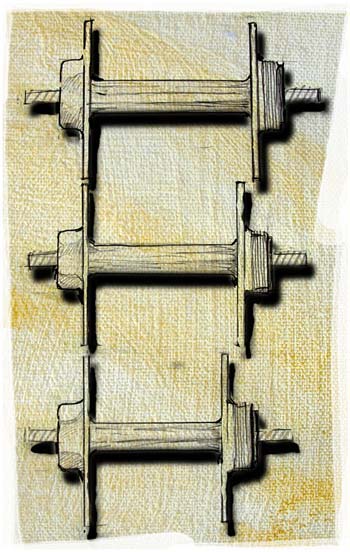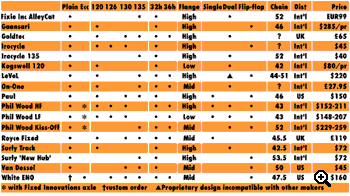[ 63XC.COM | HOW TO | HUB PICK ]
Offroad Fixed Gear Hubs: Your Pick
Here at the heart of the 63xc.com empire, we like to hear from our readers. It makes these lonely nights worthwhile. However, one form of communication we don't enjoy is The Hub Letter. This typically begins "Yo, dude" and goes on "I wanna fix up my 1995 Sasquatch Unpronounceable. Gotta oldskool Spurt Bros Sumpdweller crank--yaknow, the one with the quad ring option. What fits right in there?" The Hub Letter is a thankless task. Literally. We write careful detailed replies to queries. An amazing number of correspondents feel no obligation to write back. This tends to sap what remains of our faith in human nature. But it's also a bunch of work. Taking a fixed gear bike offroad is still an unusual thing to do, and picking an appropriate hub for a given bike and rider takes time and thought. Given that some of the hubs on the Links page are known to us only by their spec sheets, making a recommendation can seem like a big responsibility. Here's the 63xc.com guide to picking your own hub, complete with a feature comparison chart which is as extensive as we can make it. You're still welcome to write, of course, but read this first. Dropouts What kind of dropouts does your bike have? Until quite recently, all bikes allowed some fore-and-aft tuning of the rear wheel. This ensured a snug fit between chain and sprocket. The rider would slide the wheel into position in a horizontal dropout before tightening securing nuts to hold it in place. Getting it to sit true was a knack. In the last couple of decades, dropouts have gone vertical. The wheel drops right in, with no fine tuning. The derailleur can cope with the chain slack. But, of course, if you don't have a derailleur, chain slack will be a problem. Singlespeeders often use devices like the Surly Singleator, or even dummy derailleurs, to press-gang vertical dropout frames into service. But fixers don't have that option. (When pulling on the pedals to slow down, the usual direction of force on the chain is reversed. This will bend any extraneous devices in the chainline. Bad Thing.) Purpose-built singlespeed and fixed gear frames usually* have either old-style horizontal dropouts or so-called track ends, where the wheel slides in from the rear. So do road and mountain bikes made up to, oh, 1987. If your chosen frame is so equipped, you will have no problems. If your bike has vertical dropouts, you may still be able to make it into a fix. Try one of the following:
Want an eccentric hub? Check the chart. *If you're a singlespeeder, you may have encountered exotic frames with eccentric bottom brackets. EBB-equipped singlespeeds take up chainslack through fore-and-aft positioning of the BB axle, allowing the use of no-brainer vertical dropouts. The penalty is considerable expense and a larger-than-usual BB shell, but that hasn't stopped a few diehards from retrofitting EBBs to favourite frames. See the Craig Emenaker link in the sidebar.
Spacing What spacing does your frame have? Remove the rear wheel and measure the distance between the inner faces of the dropouts. It might be 120mm, 126mm, 130mm, or 135mm. (There are others, but we can forget them for the moment.) 120mm spacing was used on old five- and ten-speed bikes, and is still found on track bikes and on road frames built for fixed gear. 126mm and 130mm spacings are associated with more recent machines, typically roadbikes with six- and seven-speed gear clusters. 135mm spacing is associated particularly with modern mountainbikes, but may also turn up on a roadbike with lots of gears. It's nice to find a fixed gear hub that will fit your frame perfectly, but it's not always necessary. If you get a great deal on a wrong size hub, you might:
Spacer washers are fine, but coldsetting is not really a great idea, even on steel frames. Drilling Fixed wheels are inherently strong, but offroad use can be murder. We'd argue that 28h is not an option for riders weighing more than 150lb, tho' your mileage may vary. The listing shows hubs available in 32h and 36h drillings. High-flange low-flange Depending on when you joined the debate, you may believe that high flange wheels are stronger and stiffer, or that low flanges absorb bumps better. We don't have an opinion, but you can check flange size on the chart.
Flip-flop or DF? Most singlespeed hubs are unsuitable for fixed-gear use. A hub becomes ready for a fixed sprocket by virtue of a short left-hand thread, outboard of the main thread. That's where the lockring screws on. You need a lockring, no matter what anyone says.
The chart shows who builds what. Chainline Chainline is the line taken by the chain between chainwheel and sprocket. Chainline is said to be perfect when chainwheel and sprocket are coplanar, so that the chain is not deflected to the left or right in passing between them. Since it reduces wear and the risk of chain launch, perfect chainline is undoubtedly a good thing. A working derailleur system can't provide perfect chainline, but on a track bike--and by extension, any frame with 120mm dropout spacing--it's easy to achieve. Buy a track hub, sprocket, chain, crankset and BB from the same maker, and everything will line up neatly. Other forms of fix are more complicated. 126mm, 130mm and 135mm FG hubs are sold as add-ons for bikes with multiple chainrings and a variety of setups. Which ring should the sprocket line up with? Is it intended for 1/8" or 3/32" chains? Mountain or road cranks? What about the effects of different BB tapers? Where does ISIS fit in? If you want to hack a way through this jungle, check the sidebar for Sheldon Brown's article, which explains how manufacturer's chainline specifications work and then goes on to list specs for a range of popular components including chainsets, hubs, and sprockets. Clear trends emerge from Sheldon's survey. The most important is, like goes with like. Whatever your preferences, using a track chainset on an MTB or a big S/S crank on a 120mm road frame seems likely to cause trouble. Our chart builds on Sheldon's work and should be read in conjunction with it. Note, however, that we quote the manufacturer's chainline figure rather than Sheldon's centre-to-shoulder measurement. If that statement makes no sense to you, you should definitely read Sheldon's article. Over here? Fixed-gear hubs are a niche product, and niche manufacturers don't necessarily want to get involved in international shipping. Before you source a product from overseas, make sure that you can get adequate support. How much? FG hubs tend to be expensive. That's not a criticism: CNC gear is a big investment, and the smaller firms need to see a fast return. But this is a good moment to mention that manufacturers have different ideas about the appropriate kit to supply with the hub. Depending on whom you buy from, the box may contain anything from an entire mounting set plus sprocket right down to a bare shell and an instruction to buy your own lockring. Check the links off the zoomed version of the chart so you know what you're getting. Acknowledgments We did our best to make this article definitive, and most of the figures you see on the chart were checked with the manufacturers. The exception is Goldtec, who couldn't be bothered to respond to our emails. [ TOP ] |
Writer
Will Meister edits 63xc.com, but dreams all the while that he is a Wired staffer talking to Esther Dyson about the New Economy in 1996.
Date
v1.1 written May 2003, July 2003, May 2004, Feb 2006
Illustrator
The drawings are by the excellent Albert Reinhardt, who also does the little sketches on the section dividers. He's an all round design guy and has his own site where you can learn about his work and his amazing 'one buck' pricing system. Albert added his own Surly to our gallery.
Hubjub!
UK fixers can source many of the items listed on the chart from 63xc.com's e-com spinoff, Hubjub.
Related
The zoomed version of the chart includes links to all the listed makers.
You should definitely read over Sheldon Brown's chainline article before buying a hub. S/Sers may want to read Craig Emenaker on EBBs, although his excellent survey is now hosted on MTBR and is thus very, very slow.
If you think we missed a hub, drop us a line at 63xc.com.
Mailing list
Join the 63xc.com list.



